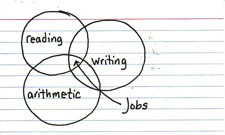 Information is expanding exponentially. Applying database concepts to your information diet can mean the difference between overload and sanity, chaos and productivity. Database fluency is mandatory in a digital world. Students and teachers should be practicing and refining this skill so that today’s learners can make the most of the sea of data they swim in.
Information is expanding exponentially. Applying database concepts to your information diet can mean the difference between overload and sanity, chaos and productivity. Database fluency is mandatory in a digital world. Students and teachers should be practicing and refining this skill so that today’s learners can make the most of the sea of data they swim in.
Almost anything you encounter in digital format can be managed using database techniques. At their root Facebook (relationships), iTunes (music, movies, tv, books, etc.), del.icio.us (bookmarks), flickr (photos), Moodle (lesson plans, learning management), and We Are Teachers (referrals) share a common database DNA. Even blogs through their categories and tag clouds are databases.
Email is an example. Treat the sender’s address as a data point. Then set up rules (database queries) to have all your boss’s emails sent to a high priority folder and Aunt Mabel’s political ravings sent straight to the trash. This approach allows you to target the urgent items amidst a sea of dross.
The Education Need
Educators and educational publishers have a vital role to play in our move to a database driven world. Why?
- Students need to develop database fluency if they are going to get the most out of their digital lives. Learning Management Systems (LMS), social networks, and on-line research are all core tools for 21st Century education. Database fluency should become part of the curriculum along with textual, numerical, and visual fluencies.
- Teachers need access to networks of peers, experts, and content to be able to deliver on the promise of individualized instruction.
- Administrators and Policy Makers need to measure results across groups and efficiently allocate resources.
Every one of these needs is best met by a database and fluent users.
The Goal
The end result should be personal growth, valued relationships, and effective organizations. But in the first flush of widespread adoption we are losing sight of this. Consider the statement “I “friended” 1,000 people on Facebook therefor I have 1,000 friends.” Wrong. Many people are confusing the database with their relationships.
A teacher could take the Facebook example above and build an interesting set of discussions around the meaning of friendship, how to find a small network of people who are interested in the same things you are, what you can do to contribute, and how to manage the relationships that emerge. It isn’t creating huge numbers of meaningless connections that matters – it is finding the needles in the haystack of humanity that you want to build bonds of friendship with.
Database Fluency
What is database fluency – what are the core skills proficient users need to master?
- Ubiquity – See every digital file you touch as a potential data point. Emails, MP3 files, Word documents, student records, and your photos are all potential data points.
- Searching – Understanding how to craft logical questions that return useful information takes ongoing practice (“and”, “or”, “greater than”, “before”, etc.). Learning to to harness the advanced search features almost all applications have is another part of this skill.
- Homing – The ability to find what is meaningful and valuable in large data sets by asking the right questions at the right time. Is this a reliable source? How recent is the data? Does this address the question I set out to answer? Is it usable or a tangled mess? How does it compare with other results?
- Tagging – Users tag data elements to personalize them. This can be through formal taxonomies provided by the database author (“Male, Female”) or informal folksonomies created on the fly by users (flickr tag clouds). Since tagging is so open-ended having some basic rules in place can help insure you are able to use the tag cloud later to search the data.
- Cleaning – Any collection of data gets messy after a while – knowing how to clean your data just like you clean your room is an essential part of working with large data sets. Without maintenance your searching and tagging get bogged down.
- Reporting – Creating clear usable reports that make the point you are after is an important part of turning data into information and eventually into wisdom. When is a table better than a bar chart? Should I focus on 5 or 500 names?
None of this involves database programming. That is a skill more akin to auto mechanics – I don’t need to know how to tune my engine to drive a car. I also don’t need to know SQL to use a social networking site. However, for driving and networking I do need to know the rules of the road and how navigate where I want to go.
How these elements appear in different applications varies widely – understanding the underlying dynamics helps harness their power across many environments.
RSS readers click through to see the full article – 3 detailed examples that bring these concepts to life and some suggestions on where to start.
Continue reading
 EdNet 2009 starts this Sunday in Chicago. This is one of the three most important events of the year* for networking and professional development in the education industry. I’ve been attending since the early 90’s with only a couple of absences.
EdNet 2009 starts this Sunday in Chicago. This is one of the three most important events of the year* for networking and professional development in the education industry. I’ve been attending since the early 90’s with only a couple of absences. The Education Business Blog
The Education Business Blog


 Special Education appears to be the first K12 market segment seeing the education stimulus dollars flow in volume.
Special Education appears to be the first K12 market segment seeing the education stimulus dollars flow in volume. At 35,000 feet, with a steaming Starbucks and a purring iPod I read my Grandfather’s memoirs last Wednesday. I’d already put in several hours of work when I decided to crack the sheaf of Xeroxed reflections written three years before he passed in 1964.
At 35,000 feet, with a steaming Starbucks and a purring iPod I read my Grandfather’s memoirs last Wednesday. I’d already put in several hours of work when I decided to crack the sheaf of Xeroxed reflections written three years before he passed in 1964. The
The 
 What are the prospects for raising capital for education technology companies in the current financial meltdown? Last week at the
What are the prospects for raising capital for education technology companies in the current financial meltdown? Last week at the  This panel is made up of seasoned veterans of the M&A markets for Education Technology companies. They addressed the K12, Higher Education / Post-secondary, and general M&A climate.
This panel is made up of seasoned veterans of the M&A markets for Education Technology companies. They addressed the K12, Higher Education / Post-secondary, and general M&A climate.


 As print and technology products in education blend together the distinctions between textbook publishers and ed-tech providers are blurring in some very interesting ways.
As print and technology products in education blend together the distinctions between textbook publishers and ed-tech providers are blurring in some very interesting ways. Information is expanding
Information is expanding